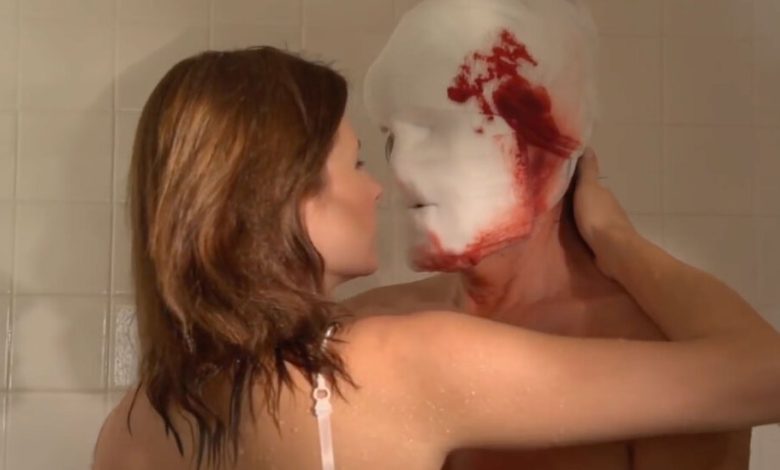What Distinguishes a Neil Breen Film? Neil Breen.

A mysterious orb blares across the sky and punches into the sun-baked bed of a desert landscape. From it a messianic being emerges. For the viewer it’s at this point, early in the 2009 film “I Am Here …. Now,” that the proceedings veer in one of two directions: a solemn polemic about drug use, corporate corruption and environmental exploitation; or an endearingly inept science-fiction parable, the charms of which center wholly on the middle-aged man who plays the alien being. His name is Neil Breen.
Breen has produced, written, directed and starred in five films. His sixth, “Cade: The Tortured Crossing,” just opened in select theaters (it screens in New York in August), and if the trailer is any indication, then his singular, if peculiar, vision has remained intact.
For the past 18 years Breen has been making imaginative but bewildering low-budget paranormal thrillers in and near his suburban Las Vegas home. Some concern interstellar visitors like the one in “I Am Here …. Now”; others focus on hackers with superhuman abilities. There are talismanic crystals, mystical animals (predominantly eagles or tigers), and what I assume is Breen’s own Ferrari Testarossa. His dialogue tends to be peppered with technological keywords: artificial intelligence, cyberterrorism, metaverse, virtual reality — concepts that Breen never convincingly grasps and that seem abstract considering his films look as if they were made for tens of thousands of dollars. (Breen claims to have funded his early films with his income as an architect.)
He serves in multiple roles in each production: location manager, music director, sound effects supervisor, editor, lighting designer, set designer, special effects designer, prop master, stunt coordinator, even legal and accounting services. And it’s his face emblazoned on each poster, making it indisputably clear that the distinguishing feature of a Neil Breen film is Neil Breen.
“I am honestly sincerely doing the best I can, with the resources that I have, both physically and financially,” Breen said in a 2014 interview with New York Cine Radio. (He didn’t respond to interview requests for this article.)
If resourcefulness is considered one of the core tenets of independent film, then Breen could be one of the central filmmakers of the past two decades. When he talks about his work, he tends to proudly reiterate the same anecdotes about how he assembles his casts via Craigslist ads or how he corresponds directly with the theaters that exhibit his work. Instead of ruminating on the meaning of his ambitious if barely coherent forays into science fiction, he’ll explain at length how he feeds his cast and crew.
Breen’s entire cinematic approach can be encapsulated in a backyard cookout scene in “Fateful Findings” (2013), in which the characters are actually eating. You get the sense that Breen’s intent here was to simultaneously direct, act and do the catering.

A scene from “Fateful Findings” (2013). The drama covers alcoholism, painkiller addiction and unrequited love, but also teleportation.Credit…Neil Breen Films, LLC
“There’s an uncanny quality,” Cristina Cacioppo, a director of programming at Nitehawk Cinema in Brooklyn, said when asked to describe Breen’s films. “Sort of a resemblance to reality, but just sort of like otherworldly.”
All of Breen’s films seem clearly to mean something, and watching them, one’s suspension of disbelief is constantly threatened by strange directorial choices. Even when they’re 90 minutes, some feel interminable. In a simple scene of dialogue he’ll freely break the 180-degree rule, a basic staging technique meant to keep the viewer oriented. His later films make generous use of composite photography, and characters will be both uncannily too large and too small in the same ethereal vista. My favorite among his many idiosyncrasies is the thunderously expository dialogue. This is from the 2016 “Pass-Thru”:
None of this logically anticipates Breen’s dire, cartoonishly violent narratives. “Pass-Thru” culminates in his darkest sequence, with Thgil — another of the messianic aliens in which Breen specializes — walking toward the horizon’s vanishing point. The landscape is strewn with hundreds of thousands of bodies, a genocide he’s issued as punishment for those who’ve abused Earth’s precious resources.
“Fateful Findings,” which I and many others consider Breen’s most deranged film, exemplifies the tonal stiltedness and libertarian rage that pervades his work. The first two-thirds qualify as a drama, marked by alcoholism, painkiller addiction and unrequited love. By the time it ends there has been an abduction, murders, teleportation and a revelatory news conference that culminates in six consecutive suicides.
With each production, Breen’s audience, drawn from word of mouth and social media, has grown. He began to raise interest when “I Am Here …. Now” played at West Coast theaters like the now defunct Cinefamily in West Hollywood, Calif., where it was marketed as a hilarious oddity.
For many audiences the natural response to Breen’s films is laughter. He’s often likened to Tommy Wiseau, whose “The Room” (2003) is considered one of the worst movies ever made, or Ed Wood, whose charmingly ramshackle genre exercises from the 1950s might be considered forerunners of Breen’s work. But these comparisons are shallow. By the end of his career Wood had fallen into obscurity, directing pornography under a pseudonym. And Wiseau seems to have succumbed by self-parody. His six-episode sitcom, “The Neighbors,” and his appearances in other films (like “Samurai Cop 2: Deadly Vengeance”) demonstrate none of “The Room’s” manic power.
Breen is still making films under the same unpretentious conditions, which is to say they’re just as incoherent as ever, even if they’ve evolved in technical ambition. Whereas his early films favored suburban Las Vegas and the nearby desert, his 2018 cyberthriller “Twisted Pair” is replete with green-screen photography and stock footage. Breen plays a double role, twins Cale and Cade, bestowed at birth with superhuman powers and pitted against each other with potentially world-changing consequences. The action scenes — when Cade freezes time, for instance, or leaps grasshopper-like to the upper floor of a building — contain flashes of “The Matrix.” During these sequences at a 2018 screening at the Music Box in Chicago, the crowd went berserk.
“When I used to go to see the first screenings of films like ‘Double Down’ and ‘I Am Here …. Now,’ I’d be in the back of the theater listening to the audience,” Breen said in the 2014 interview. “The audience may chuckle at parts that I never intended, but in the second half of the film they sort of begin to get it.”
Trevor Dillon, who’s programmed Breen’s work at the Frida Cinema in Santa Ana, Calif., said he thought “Neil Breen is very much like ‘I’m about the movies, I am a filmmaker, my movies play at 8 p.m.’” Dillon added that the question “is whether or not there’s a ton of self-awareness there.”
“I think he’s a scrappy independent filmmaker and I think he’s an even better businessman,” Dillon added.
Jake Isgar has programmed “Twisted Pair” and its forthcoming sequel, “Cade: The Tortured Crossing,” at Alamo Drafthouse in San Francisco. “I don’t ever want to call his movies midnight movies or create this other sort of distinction,” he said. “Why should an independent artist who’s putting his own work out there have to be ghettoized in any particular way?”
(Like me, Isgar has yet to see Breen’s newest. He said Breen “was very straightforward” and declined to send a screener to preview the film. “He says, ‘Well, you’ve seen my other movies.’”)
In his correspondence with theaters Breen stipulates that his movies should screen at around 7 p.m., and that showings should be limited to maintain demand. But embedded in such restrictions one may infer either a resistance to having his work pushed to the fringes, or a pretension in contextualizing it as a mainstream experience. Regardless, Breen’s films continue to engage audiences worldwide.
Consider a 2019 showing of “Twisted Pair” in Paris, at Le Grand Rex, the largest movie theater in Europe. At the sold-out screening, put on by the publication Nanarland (“Nanar” is a French colloquialism that roughly translates as “so bad it’s good”), the crowd “went nuts,” the Nanarland co-founder Régis Brochier said. “It was really an incredible screening.”
A clip posted to YouTube captures the mania: the roaring crowd spills out from both balconies. People start to stand and clap. The film they’re all there to see hasn’t even begun.




